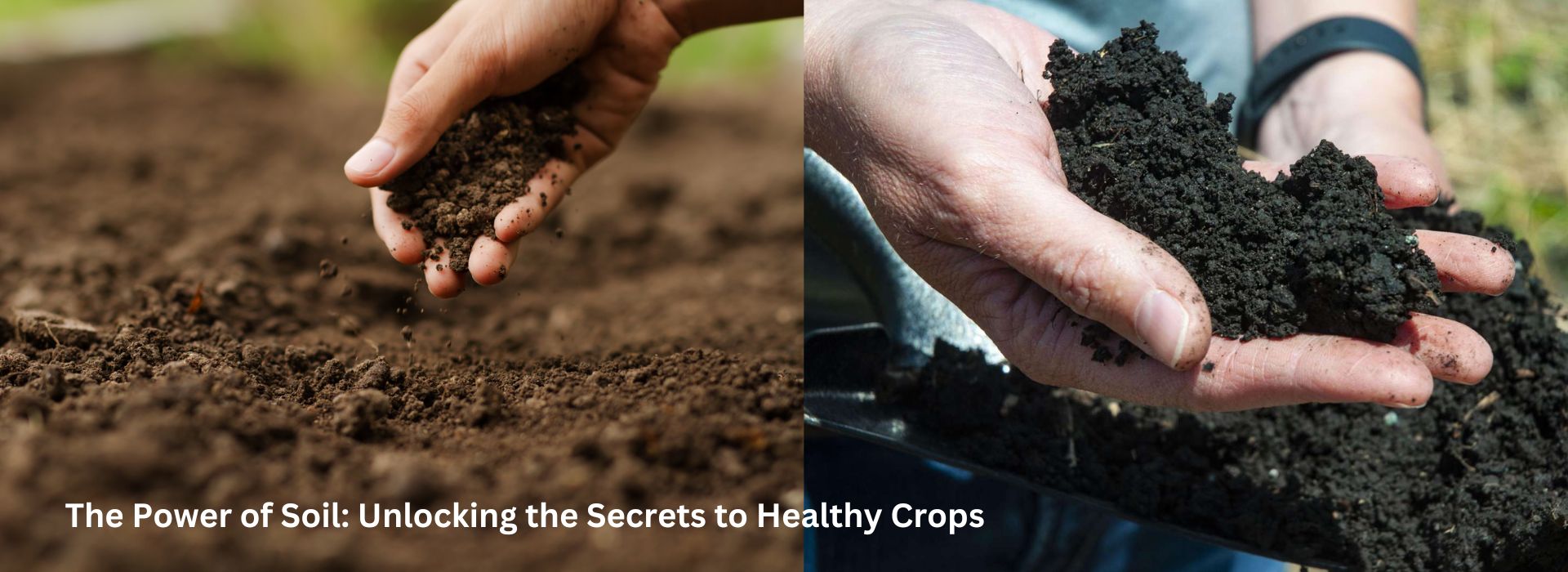The Power of Soil: Unlocking the Secrets to Healthy Crops
January 9, 2025The
Power of Soil: Unlocking the Secrets to Healthy Crops
Soil
is often called the foundation of life, and for good reason. It is the bedrock
of agriculture, providing essential nutrients, water, and support to crops.
However, soil health is frequently overlooked, even as its role in sustainable
farming becomes more crucial. This blog delves into the importance of soil, the
factors affecting its health, and practical ways to enhance it for bountiful
harvests.
Why
Soil Health Matters
Healthy
soil is the cornerstone of productive agriculture. It contributes to:
- Nutrient
Availability: Supplies
essential minerals like nitrogen, phosphorus, and potassium for crop
growth.
- Water
Retention: Acts as a
reservoir, storing water for plants during dry periods.
- Biodiversity: Supports a rich ecosystem of microbes,
fungi, and insects essential for soil fertility.
- Carbon
Sequestration: Captures
carbon dioxide, reducing greenhouse gas emissions.
In
contrast, degraded soil leads to poor crop yields, increased vulnerability to
pests and diseases, and environmental problems like erosion and pollution.
Factors
Impacting Soil Health
Several
factors influence soil quality:
- Overuse of
Chemical Fertilizers:
Excessive use can deplete organic matter and harm beneficial microbes.
- Erosion: Wind and water erosion strip topsoil,
the most nutrient-rich layer.
- Monocropping: Growing the same crop repeatedly reduces
soil fertility and invites pests.
- Over-irrigation: Leads to waterlogging, salinization, and
loss of soil structure.
- Pollution: Industrial waste and pesticide runoff
can contaminate soil, making it unfit for farming.
Unlocking
the Secrets to Healthy Soil
Improving
soil health requires a combination of traditional wisdom and modern science.
Here are actionable steps to revitalize and maintain fertile soil:
1.
Test Your Soil
Conduct
regular soil tests to understand its nutrient composition, pH levels, and
organic matter content. This helps tailor your farming practices to meet
specific soil needs.
2.
Embrace Organic Matter
Incorporate
compost, manure, and crop residues to enrich the soil with organic matter. This
boosts microbial activity, enhances nutrient availability, and improves water
retention.
3.
Rotate Crops
Adopt
crop rotation to break pest cycles, improve soil fertility, and promote
biodiversity. For instance, alternating legumes with cereals can naturally fix
nitrogen into the soil.
4.
Use Cover Crops
Grow
cover crops like clover or mustard during the off-season to prevent erosion,
add organic matter, and suppress weeds.
5.
Opt for Minimum Tillage
Reduce
tilling to preserve soil structure, retain moisture, and protect beneficial
organisms like earthworms.
6.
Implement Integrated Nutrient Management (INM)
Combine
organic and inorganic fertilizers to optimize nutrient supply without harming
soil health.
7.
Practice Precision Irrigation
Use
drip or sprinkler irrigation to provide water efficiently, preventing
waterlogging and salinization.
8.
Introduce Agroforestry
Integrate
trees with crops to stabilize soil, enhance organic matter, and improve water
cycles.
9.
Promote Soil Biodiversity
Encourage
the presence of earthworms, fungi, and microbes, which decompose organic matter
and release nutrients for crops.
Case
Studies: Soil Restoration Success
1.
The Green Revolution in Punjab, India
Excessive
chemical use during the Green Revolution initially boosted yields but led to
soil degradation. Farmers are now adopting organic farming and crop
diversification to restore soil health.
2.
Regenerative Agriculture in Brazil
Brazilian
farmers are using no-till farming and cover crops to combat soil erosion and
enhance carbon sequestration, turning degraded lands into productive fields.
3.
Desert Farming in Israel
Through
soil conditioning and precision irrigation, Israeli farmers have transformed
arid desert soils into fertile farmlands, demonstrating the power of innovation
in soil management.
Benefits
of Healthy Soil
- Higher
Yields: Healthy
soil supports robust crop growth, leading to increased productivity.
- Cost
Savings: Reduced
dependence on fertilizers and pesticides lowers input costs.
- Environmental
Protection: Improved
soil health reduces runoff and protects nearby ecosystems.
- Resilience
to Climate Change:
Healthy soils act as carbon sinks and retain water, making crops more
resilient to droughts and floods.
Challenges
in Maintaining Soil Health
- Lack of
Awareness: Many
farmers are unaware of sustainable soil practices.
- High Costs: Organic inputs and advanced technologies
may be expensive for small-scale farmers.
- Policy Gaps: Insufficient government incentives for
sustainable farming practices.
The
Path Forward
The
future of agriculture depends on healthy soil. Governments, researchers, and
farmers must collaborate to:
- Promote
awareness about soil health through training programs.
- Provide
subsidies for sustainable farming inputs.
- Invest in
research to develop region-specific soil management practices.
- Encourage
the adoption of soil-friendly technologies like precision farming.
Conclusion
Soil
is more than just dirt—it’s a living, breathing entity that sustains life on
Earth. By prioritizing soil health, we can ensure long-term agricultural
productivity, environmental sustainability, and food security. The journey to
healthier crops begins with healthier soil.
At krishibazaar.in,
you can find and buy various agricultural products. For agricultural guidance
on selecting the most suitable products for your crops, please contact or
WhatsApp at +917887880887






Guest reviews
No reviews found for this Blog